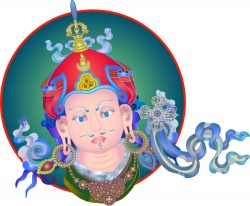Difference between revisions of "Āstika and nāstika"
| Line 5: | Line 5: | ||
In non-technical usage, the term [[āstika]] is sometimes loosely translated as "[[theist]]", while {{Wiki|nāstika}} is translated as "[[atheist]]". However, this interpretation is {{Wiki|distinct}} from the use of the term in {{Wiki|Hindu philosophy}}. Notably even among the [[āstika]] schools, [[Sāṃkhya]] is an {{Wiki|atheistic}} [[philosophy]]. | In non-technical usage, the term [[āstika]] is sometimes loosely translated as "[[theist]]", while {{Wiki|nāstika}} is translated as "[[atheist]]". However, this interpretation is {{Wiki|distinct}} from the use of the term in {{Wiki|Hindu philosophy}}. Notably even among the [[āstika]] schools, [[Sāṃkhya]] is an {{Wiki|atheistic}} [[philosophy]]. | ||
| − | The different usages of these terms are explained by Chatterjee and [[Datta]] as follows: | + | The different usages of these terms are explained by [[Chatterjee]] and [[Datta]] as follows: |
In {{Wiki|modern}} [[Indian]] [[languages]], "[[āstika]]" and "{{Wiki|nāstika}}" generally mean "[[theist]]" and "[[atheist]]", respectively. But in [[Sanskrit]] [[philosophical]] {{Wiki|literature}}, "[[āstika]]" means "[[one who believes in the authority of the Vedas]]" or "[[one who believes in life after death]]". ("{{Wiki|nāstika}}" means the opposite of these). The [[word]] is used here in the first [[sense]]. In the second [[sense]], even the [[Jaina]] and [[Buddha]] schools are "[[āstika]]", as they believe in [[life]] after [[death]]. The six {{Wiki|orthodox}} schools are "[[āstika]]", and the [[Cārvāka]] is "{{Wiki|nāstika}}" in both the [[senses]]. | In {{Wiki|modern}} [[Indian]] [[languages]], "[[āstika]]" and "{{Wiki|nāstika}}" generally mean "[[theist]]" and "[[atheist]]", respectively. But in [[Sanskrit]] [[philosophical]] {{Wiki|literature}}, "[[āstika]]" means "[[one who believes in the authority of the Vedas]]" or "[[one who believes in life after death]]". ("{{Wiki|nāstika}}" means the opposite of these). The [[word]] is used here in the first [[sense]]. In the second [[sense]], even the [[Jaina]] and [[Buddha]] schools are "[[āstika]]", as they believe in [[life]] after [[death]]. The six {{Wiki|orthodox}} schools are "[[āstika]]", and the [[Cārvāka]] is "{{Wiki|nāstika}}" in both the [[senses]]. | ||
| Line 43: | Line 43: | ||
— | — | ||
| − | [[Tantric]] [[traditions]] in [[Hinduism]] have both [[āstika]] and {{Wiki|nāstika}} lines; as Banerji writes in "[[Tantra]] in {{Wiki|Bengal}}": | + | [[Tantric]] [[traditions]] in [[Hinduism]] have both [[āstika]] and {{Wiki|nāstika}} lines; as [[Banerji]] writes in "[[Tantra]] in {{Wiki|Bengal}}": |
| − | [[Tantras]] are ... also divided as [[āstika]] or {{Wiki|Vedic}} and {{Wiki|nāstika}} or non-Vedic. In accordance with the predominance of the [[deity]] the [[āstika]] works are again divided as Śākta, [[Śaiva]], Saura, Gāṇapatya and [[Vaiṣṇava]]. | + | [[Tantras]] are ... also divided as [[āstika]] or {{Wiki|Vedic}} and {{Wiki|nāstika}} or non-Vedic. In accordance with the predominance of the [[deity]] the [[āstika]] works are again divided as [[Śākta]], [[Śaiva]], [[Saura]], [[Gāṇapatya]] and [[Vaiṣṇava]]. |
— | — | ||
| Line 62: | Line 62: | ||
[[Bhavaviveka]] declares that [[Buddhists]] are not [[nastika]] by refuting the [[nihilists]] {{Wiki|annihilation}} of '[[karmaphalasambandha]]' and demonstrating the [[transmigration]] of [[sentient beings]]. | [[Bhavaviveka]] declares that [[Buddhists]] are not [[nastika]] by refuting the [[nihilists]] {{Wiki|annihilation}} of '[[karmaphalasambandha]]' and demonstrating the [[transmigration]] of [[sentient beings]]. | ||
| − | According to the [[Sallekha Sutta]], [[belief]] leading to [[evil]] conduct is of three kinds, and [[natthika | + | According to the [[Sallekha Sutta]], [[belief]] leading to [[evil]] conduct is of three kinds, and [[natthika ditthi]] ([[nastikavada]] or [[nihilism]]), is one of them (the others being [[ahetuka ditthi]] or {{Wiki|accidentalism}} and [[akiriya ditthi]] or the [[view]] of inaction). |
According to [[Buddhist texts]], [[Astikavada]] is also known as [[Sabbathikavada]]. | According to [[Buddhist texts]], [[Astikavada]] is also known as [[Sabbathikavada]]. | ||
Latest revision as of 21:26, 3 January 2015
Āstika (Sanskrit: आस्तिक āstika; "it exists") and Nāstika (नास्तिक, nāstika; "it doesn't exist") are technical terms in Hinduism used to classify philosophical schools and persons, according to whether they accept the authority of the Vedas as supreme revealed scriptures, or not, respectively. By this definition, Nyāyá, Vaiśeṣika, Sāṃkhya, Yoga, Mīmāṃsā and Vedānta are classified as āstika schools; and some schools like Cārvāka, Ājīvika, Jainism and Buddhism are considered nāstika. The distinction is similar to the orthodox/heterodox distinction in the West.
In non-technical usage, the term āstika is sometimes loosely translated as "theist", while nāstika is translated as "atheist". However, this interpretation is distinct from the use of the term in Hindu philosophy. Notably even among the āstika schools, Sāṃkhya is an atheistic philosophy.
The different usages of these terms are explained by Chatterjee and Datta as follows:
In modern Indian languages, "āstika" and "nāstika" generally mean "theist" and "atheist", respectively. But in Sanskrit philosophical literature, "āstika" means "one who believes in the authority of the Vedas" or "one who believes in life after death". ("nāstika" means the opposite of these). The word is used here in the first sense. In the second sense, even the Jaina and Buddha schools are "āstika", as they believe in life after death. The six orthodox schools are "āstika", and the Cārvāka is "nāstika" in both the senses.
Etymology
Āstika (IAST: āstika) is a Sanskrit adjective (and noun) that is derived from asti ("it is or exists") meaning "believing" or "pious"; or "one who believes in the existence ." Nāstika (na (not) + āstika) is its negative, literally meaning "not believing" or "not pious". As used in Hindu philosophy the differentiation between āstika and nāstika refers to belief in Vedic authority, not belief or lack of belief in theism. As N. N. Bhattacharyya writes:
The followers of Tantra are often branded as Nāstika by the upholders of the Vedic tradition. The term Nāstika does not denote an atheist. It is applied only to those who do not believe in the Vedas. The Sāṃkhyas and Mīmāṃsakas do not believe in God, but they believe in the Vedas and hence they are not Nāstikas. The Buddhists, Jains, and Cārvākas do not believe in the Vedas; hence they are Nāstikas.
—
Classification of schools
Āstika
Several Indian intellectual traditions were codified during the medieval period into a standard list of six orthodox systems or ṣaḍdarśanas, all of which cite Vedic authority as their source. Nyaya, Vaisheshika, Samkhya, Yoga, Mimāṃsā and Vedanta are classified as āstika schools:
Nyāyá, the school of logic
Vaiśeṣika, the atomist school
Sāṃkhya, the enumeration school
Yoga, the school of Patañjali (which assumes the metaphysics of Sāṃkhya)
Mimāṃsā, the tradition of Vedic exegesis
Vedanta or Uttara Mimāṃsā, the Upaniṣadic tradition.
These are often coupled into three groups for both historical and conceptual reasons: Nyāyá-Vaiśeṣika, Sāṃkhya-Yoga, and Mimāṃsā-Vedanta.
Nāstika
The main schools of Indian philosophy that do not base their beliefs on the Vedas were regarded as heterodox by Brahmins:
Buddhism
Jainism
Cārvāka
Ājīvika
The use of the term nāstika to describe Buddhism and Jainism in India is explained by Gavin Flood as follows:
At an early period, during the formation of the Upaniṣads and the rise of Buddhism and Jainism, we must envisage a common heritage of meditation and mental discipline practiced by renouncers with varying affiliations to non-orthodox (Veda-rejecting) and orthodox (Veda-accepting) traditions.... These schools [such as Buddhism and Jainism] are understandably regarded as heterodox (nāstika) by orthodox (āstika) Brahmanism.
—
Tantric traditions in Hinduism have both āstika and nāstika lines; as Banerji writes in "Tantra in Bengal":
Tantras are ... also divided as āstika or Vedic and nāstika or non-Vedic. In accordance with the predominance of the deity the āstika works are again divided as Śākta, Śaiva, Saura, Gāṇapatya and Vaiṣṇava.
—
Zoroastrianism is not literally nastika (because of rejecting devas), but is adevism.
Jain usage
Jains themselves have been branded nastikas for not accepting the Vedas, and they in turn have accused many non-Jains of being Nastikas. According to Jainism, nastikavada is a system of beliefs that are nastika in nature. Jains assign the term nastika to one who is ignorant of the meaning of the religious texts or those who deny the existence of the soul.
The Jains acharyas, Manibhadra and Haribhadra associated Jainism of astika classification and associated the Lokayata (Charvaka) philosophy with nastika.
Buddhist usage
Although Buddhists have been branded by orthodox or mainstream Hinduism as Nastika, the Buddhists themselves have branded only the Cārvākas as nastika. For example Nagarjuna wrote in his Ratnavali, that nastikya (nihilism) leads to hell while astikya (affirmation) leads to heaven. Further, the Madhyamika philosopher Chandrakirti, who was accused of being a nastik, wrote in his Prasannapada that emptiness is a method of affirming neither being nor non-being and that nihilists are actually naive realists because they assume that things of this world have self-existent natures, whereas Madhyamikas view all things as arising dependently within the context of casual conditions.
There were also Buddhists that were accused of believing in ideas outside of the Buddha's teachings, and they were called nastika in the "Bodhisattvabhumi" (a section of the Yogacarabhumi by Asanga) and the scripture also declared they should be subject to isolation so their views do not infect the rest of the Buddhist community. Like the Manusmriti, the Bodhisattvabhumi also criticizes the nastika for reliance on logic only.
Bhavaviveka declares that Buddhists are not nastika by refuting the nihilists annihilation of 'karmaphalasambandha' and demonstrating the transmigration of sentient beings.
According to the Sallekha Sutta, belief leading to evil conduct is of three kinds, and natthika ditthi (nastikavada or nihilism), is one of them (the others being ahetuka ditthi or accidentalism and akiriya ditthi or the view of inaction).
According to Buddhist texts, Astikavada is also known as Sabbathikavada.





